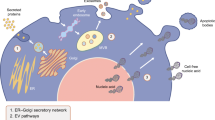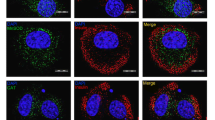Abstract
Background
Pancreatic beta cells are highly sensitive to oxidative and endoplasmic reticulum (ER) stress, commonly occurring in type 2 diabetes (T2D) and obesity.
Objective
We aimed at investigating cellular responses of human beta cells exposed to sera from obese T2D patients treated differently, namely by conventional therapy or laparoscopic sleeve gastrectomy (LSG).
Methods
Serum samples from obese T2D men randomized to conventional treatment or LSG were taken at baseline and 6 months later. After exposing 1.1B4 cells to study patients’ sera, the following were assessed: cellular viability and proliferation (by MTT and xCELLigence assays), reactive oxygen species (ROS) production (with DCFH-DA), and expression of ER stress markers, oxidative- or autophagy-related proteins and insulin (by real-time PCR and Western blot).
Results
At 6-month follow-up, patients undergoing LSG achieved an adequate glycemic control, whereas conventionally treated patients did not. As compared to 1.1B4 cells incubated with baseline sera (control), cells exposed to sera from LSG-treated participants exhibited (i) increased viability and proliferation (p < 0.05); (ii) diminished levels of ROS and p53 (p < 0.05); (iii) enhanced protein expression of autophagy-related SIRT1 and p62/SQSTM1 (p < 0.05); (iv) significantly decreased transcript levels of ER stress markers (p < 0.05); and (v) augmented insulin expression (p < 0.05). Conversely, the 6-month conventional therapy appeared not to impact on circulating redox status. Moreover, 1.1B4 cells exposed to sera from conventionally treated patients experienced mild ER stress.
Conclusion
Circulating factors in patients with improved diabetes after metabolic surgery exerted favorable effects on beta cell function and survival.





Similar content being viewed by others
References
UK Prospective Diabetes Study Group. UK Prospective Diabetes Study 16. Overview of 6 years’ therapy of type II diabetes: a progressive disease. Diabetes. 1995;44(11):1249–58.
Fonseca V, McDuffie R, Calles J, et al. Determinants of weight gain in the action to control cardiovascular risk in diabetes trial. Diabetes Care. 2013;36:2162–8.
Cummings DE, Rubino F. Metabolic surgery for the treatment of type 2 diabetes in obese individuals. Diabetologia. 2018;61(2):257–64.
Schauer PR, Bhatt DL, Kirwan JP, et al. Bariatric surgery versus intensive medical therapy for diabetes - 5-year outcomes. N Engl J Med. 2017;376:641–51.
Ferrannini E, Mingrone G. Impact of different bariatric surgical procedures on insulin action and beta-cell function in type 2 diabetes. Diabetes Care. 2009;32(3):514–20.
Dutia R, Brakoniecki K, Bunker P, et al. Limited recovery of β-cell function after gastric bypass despite clinical diabetes remission. Diabetes. 2014;63:1214–23.
Fonseca SG, Gromada J, Urano F. Endoplasmic reticulum stress and pancreatic β-cell death. Trends Endocrinol Metab. 2011;22(7):266–74.
Walter P, Ron D. The unfolded protein response: from stress pathway to homeostatic regulation. Science. 2011;334(6059):1081–6.
Oyadomari S, Mori M. Roles of CHOP/GADD153 in endoplasmic reticulum stress. Cell Death Differ. 2004;11(4):381–9.
White MG, Shaw JA, Taylor R. Type 2 diabetes: the pathologic basis of reversible β-cell dysfunction. Diabetes Care. 2016;39(11):2080–8.
Leonetti F, Capoccia D, Coccia F, et al. Obesity, type 2 diabetes mellitus, and other comorbidities: a prospective cohort study of laparoscopic sleeve gastrectomy vs medical treatment. Arch Surg. 2012;147(8):694–700.
Stefan DS, Mihai A, Bajko D, et al. Comparison of sleeve gastrectomy and conservatory treatment effect on biochemical and hormonal profile of obese type 2 diabetes subjects: CREDOR randomized controlled study results. Rev.Chim. 2017;68(7):1622–7.
Matthews DR, Hosker JP, Rudenski AS, et al. Homeostasis model assessment: insulin resistance and beta-cell function from fasting plasma glucose and insulin concentrations in man. Diabetologia. 1985;28(7):412–9.
Hayes HL, Peterson BS, Haldeman JM, et al. Delayed apoptosis allows islet β-cells to implement an autophagic mechanism to promote cell survival. PLoS One. 2017;12(2):e0172567.
Ryan KK, Tremaroli V, Clemmensen C, et al. FXR is a molecular target for the effects of vertical sleeve gastrectomy. Nature. 2014;509:183–8.
Motta MC, Divecha N, Lemieux M, et al. Mammalian SIRT1 represses forkhead transcription factors. Cell. 2004;116:551–63.
Luu L, Dai FF, Prentice KJ, et al. The loss of Sirt1 in mouse pancreatic beta cells impairs insulin secretion by disrupting glucose sensing. Diabetologia. 2013;56(9):2010–20.
Li Y, Xu S, Giles A, et al. Hepatic overexpression of SIRT1 in mice attenuates endoplasmic reticulum stress and insulin resistance in the liver. FASEB J. 2011;25:1664–79.
Guo H, Chen Y, Liao L, et al. Resveratrol protects HUVECs from oxidized-LDL induced oxidative damage by autophagy upregulation via the AMPK/SIRT1 pathway. Cardiovasc Drugs Ther. 2013;27:189–98.
Geetha T, Zheng C, Vishwaprakash N, et al. Sequestosome 1/p62, a scaffolding protein, is a newly identified partner of IRS-1 protein. J Biol Chem. 2012;287(35):29672–8.
Park JS, Oh SY, Lee DH, et al. p62/SQSTM1 is required for the protection against endoplasmic reticulum stress-induced apoptotic cell death. Free Radic Res. 2016;50(12):1408–21.
Kennedy J, Katsuta H, Jung MH, et al. Protective unfolded protein response in human pancreatic beta cells transplanted into mice. PLoS One. 2010;5:e11211.
Yang H, Liu R, Cui Z, et al. Functional characterization of 58-kilodalton inhibitor of protein kinase in protecting against diabetic retinopathy via the endoplasmic reticulum stress pathway. Mol Vis. 2011;17:78–84.
Synofzik M, Haack TB, Kopajtich R, et al. Absence of BiP co-chaperone DNAJC3 causes diabetes mellitus and multisystemic neurodegeneration. Am J Hum Genet. 2014;95(6):689–97.
Wilhelm M, Schlegl J, Hahne H, et al. Mass-spectrometry-based draft of the human proteome. Nature. 2014;509:582–7.
Vogel C, Marcotte EM. Insights into the regulation of protein abundance from proteomic and transcriptomic analyses. Nat Rev Genet. 2012;13(4):227–32.
Schwanhäusser B, Busse D, Li N, et al. Global quantification of mammalian gene expression control. Nature. 2011;473(7347):337–42.
Liew H-K, Chen P-K, Peng H-F, et al. Downregulation of GRP78 chaperone protein triggers pro-apoptotic CHOP signaling cascade in acute intracerebral hemorrhage rats. FASEB J. 2017;31(1 Suppl):815.5.
Wang J, Lee J, Liem D, et al. HSPA5 gene encoding Hsp70 chaperone BiP in the endoplasmic reticulum. Gene. 2017;618:14–23.
Han J, Back SH, Hur J, et al. ER-stress-induced transcriptional regulation increases protein synthesis leading to cell death. Nat Cell Biol. 2013;15:481–90.
Huang CJ, Lin CY, Haataja L, et al. High expression rates of human islet amyloid polypeptide induce endoplasmic reticulum stress mediated beta-cell apoptosis, a characteristic of humans with type 2 but not type 1 diabetes. Diabetes. 2007;56(8):2016–27.
Teodoro T, Odisho T, Sidorova E, et al. Pancreatic β-cells depend on basal expression of active ATF6α-p50 for cell survival even under non-stress conditions. Am J Physiol Cell Physiol. 2012;302:C992–1003.
Acknowledgments
We are grateful to all the patients who participated in this study. We would like to thank Dr. Daniela Lixandru (Carol Davila University of Medicine and Pharmacy, Bucharest) for providing the 1.1B4 pancreatic beta cells. We also acknowledge the valuable technical assistance of Ms. Marilena Isachi and Ms. Marcela Toader.
Funding
This study was supported by the Romanian National Authority for Scientific Research and Innovation, CNCS-UEFISCDI, through the projects PN-II-PT-PCCA-2013-4-2154, PN-III-P1-1.2-PCCDI-2017-0797, and PN-III-P1-1.2-PCCDI-2017-0527 and by the Romanian Academy.
Author information
Authors and Affiliations
Corresponding author
Ethics declarations
Conflict of Interest
The authors declare that they have no conflict of interest.
Informed Consent
Informed consent was obtained from all individual participants included in the study.
Statement of Human and Animal Rights
All procedures performed in studies involving human participants were in accordance with the ethical standards of the institutional and /or national research committee and with the 1964 Helsinki declaration and its later amendments or comparable ethical standards.
Additional information
Publisher’s Note
Springer Nature remains neutral with regard to jurisdictional claims in published maps and institutional affiliations.
Rights and permissions
About this article
Cite this article
Constantin, A., Dumitrescu, M., Nemecz, M. et al. Sera of Obese Type 2 Diabetic Patients Undergoing Metabolic Surgery Instead of Conventional Treatment Exert Beneficial Effects on Beta Cell Survival and Function: Results of a Randomized Clinical Study. OBES SURG 29, 1485–1497 (2019). https://doi.org/10.1007/s11695-019-03710-0
Published:
Issue Date:
DOI: https://doi.org/10.1007/s11695-019-03710-0




